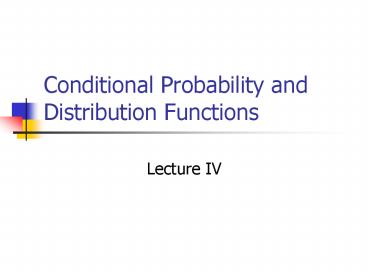Conditional Probability and Distribution Functions PowerPoint PPT Presentation
1 / 30
Title: Conditional Probability and Distribution Functions
1
Conditional Probability and Distribution Functions
- Lecture IV
2
Conditional Probability and Independence
- In order to define the concept of a conditional
probability it is necessary to define joint and
marginal probabilities. - The joint probability is the probability of a
particular combination of two or more random
variables. - Taking the role of two die as an example, the
probability of rolling a 4 on one die and a 6 on
the other die is 1/36.
3
- There are 36 possible outcomes of the two die
1,1,1,2,2,1,2,2,6,6. - Therefore the probability of a 4,6 given that
the die are fair is 1/36.
4
- The marginal probability is the probability one
of the random variables irrespective of the
outcome of the other variable. - Going back to the die example, there are six
different rolls of the die where the value of the
first die is 4 - 4,1,4,2,4,3,4,4,4,5,4,6
5
- Hence, again assume that the die are fair the
marginal probability of x1 4 is
6
- The conditional probability is then the
probability of one event, such as the probability
that the first die is a 4, given that the value
of another random variable is known, such as the
fact that the value of the second die roll is
equal to 6. In the forgoing example, the case of
the fair die, this value is 1/6
7
- Definition 2.11 Given that A and B are sets
defined on C the Axioms of Conditional
Probability are - PAB 0 for all A,
- PAA 1
- If Ai n Bi are mutually exclusive events
8
- If B ? H , B ? G, and PG ? 0, then
- The first 3 conditions follow the general axioms
of probability theory. - The final condition states that the relative
probability of a conditional event and marginal
distribution functions are the same.
9
- Given this construction the conditional
probability can be derived as - In our discussion of the role of the die
10
- Given that the events A1, A2, An are mutually
exclusive events such that PA1?A2 ?An 1 the
conditional probability can then be extended to
Bayes Theorem
11
- Given that
- Substituting this result into the previous
expression
12
- This expression unifies the simple expression in
Equation 2.15. Specifically, following the Axioms
of Probability (Condition 3). - Thus, the denominator of Equation 2.19 becomes
13
- Given that A1, A2, An are exhaustive, or A1?A2
?AnC the entire sample space since PA1?A2
?An 1) - with the last equality since E ? C.
- Returning to the numerator in Equation 2.17
14
- Definition 2.12 Two events A and B are
independent if PA PAB. - In our discussion of rolling two die above
15
Independence of Three Random Variables
16
Some Useful Distribution Functions
- Univariate normal distribution
17
- Multivariate normal distribution
18
- Univariate uniform Distribution
19
- Multivariate uniform distribution
20
- To examine the conditional properties of the
bivariate uniform distribution, we start by
deriving the marginal distribution of x1. This
marginal distribution is derived by integrating
out x2.
21
- The conditional distribution for x2 given the
value of x1 is then written as - Therefore we conclude that x1 and x2 are
independent since
22
- Univariate Gamma
23
Transformation of Random Variables
- Another alternative is to create a new
distribution by transforming one random variable
into another with a known distribution. - Nested probability functions
24
(No Transcript)
25
(No Transcript)
26
Triangular Distribution Function
27
(No Transcript)
28
(No Transcript)
29
(No Transcript)
30
Empirical Example

